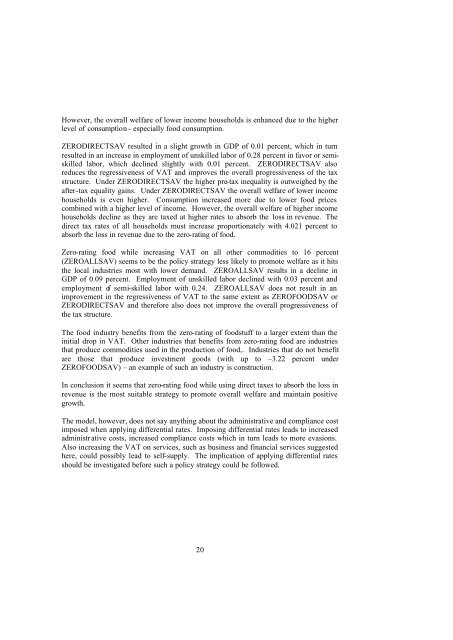Marna Kearney - tips
Marna Kearney - tips
Marna Kearney - tips
Create successful ePaper yourself
Turn your PDF publications into a flip-book with our unique Google optimized e-Paper software.
However, the overall welfare of lower income households is enhanced due to the higherlevel of consumption - especially food consumption.ZERODIRECTSAV resulted in a slight growth in GDP of 0.01 percent, which in turnresulted in an increase in employment of unskilled labor of 0.28 percent in favor or semiskilledlabor, which declined slightly with 0.01 percent. ZERODIRECTSAV alsoreduces the regressiveness of VAT and improves the overall progressiveness of the taxstructure. Under ZERODIRECTSAV the higher pre-tax inequality is outweighed by theafter-tax equality gains. Under ZERODIRECTSAV the overall welfare of lower incomehouseholds is even higher. Consumption increased more due to lower food pricescombined with a higher level of income. However, the overall welfare of higher incomehouseholds decline as they are taxed at higher rates to absorb the loss in revenue. Thedirect tax rates of all households must increase proportionately with 4.021 percent toabsorb the loss in revenue due to the zero-rating of food.Zero-rating food while increasing VAT on all other commodities to 16 percent(ZEROALLSAV) seems to be the policy strategy less likely to promote welfare as it hitsthe local industries most with lower demand. ZEROALLSAV results in a decline inGDP of 0.09 percent. Employment of unskilled labor declined with 0.03 percent andemployment of semi-skilled labor with 0.24. ZEROALLSAV does not result in animprovement in the regressiveness of VAT to the same extent as ZEROFOODSAV orZERODIRECTSAV and therefore also does not improve the overall progressiveness ofthe tax structure.The food industry benefits from the zero-rating of foodstuff to a larger extent than theinitial drop in VAT. Other industries that benefits from zero-rating food are industriesthat produce commodities used in the production of food,. Industries that do not benefitare those that produce investment goods (with up to –3.22 percent underZEROFOODSAV) – an example of such an industry is construction.In conclusion it seems that zero-rating food while using direct taxes to absorb the loss inrevenue is the most suitable strategy to promote overall welfare and maintain positivegrowth.The model, however, does not say anything about the administrative and compliance costimposed when applying differential rates. Imposing differential rates leads to increasedadministr ative costs, increased compliance costs which in turn leads to more evasions.Also increasing the VAT on services, such as business and financial services suggestedhere, could possibly lead to self-supply. The implication of applying differential ratesshould be investigated before such a policy strategy could be followed.20
















